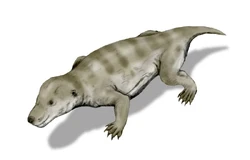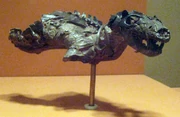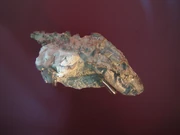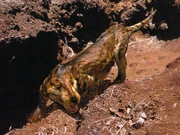| Thrinaxodon Fossil range: Early Triassic | |
|---|---|
 Restoration of Thrinaxodon. | |
| Scientific classification
| |
|
Galesauridae | |
| |
Thrinaxodon is an extinct genus of cynodont, a cat-sized Gymnotherian. Pits on the skull indicate that Thrinaxodon had whiskers and, therefore probably also had a covering of fur. There are suggestions that it was warm-blooded. Even so, it still had a reptilian skeleton and laid eggs.
Its remains were found on South Africa and Antarctica, supporting the idea that the two continents were once joined together. This animal lived during the Triassic Period (248-245 million years ago).
Its name was taken from Greek θρῖναξ "trident, three-pronged fork" and ὀδούϛ ὀδόντ- "tooth", but with a Greek language error: *"Thrinacodon" would have been the grammatically correct form.
Description[]

Thrinaxodon liorhinus

Thrinaxodon liorhinus in Cosmocaixa, Barcelona
Thrinaxodon probably lived in shallow burrows dug into hillsides or riverbanks.[1] It lived in mated pairs or small family groups, and was probably territorial, using scent glands to mark out boundaries and then defending that territory from intruders.
A low-slung, sharp-toothed carnivore, Thrinaxodon lived in burrows, and ate small creatures like insects, reptiles, etc. Clues to its remains show that this creature was more mammal-like than its synapsid ancestors. It had a fairly large head/skull with pits in the bone suggesting it had whiskers which, in turn, hints that its body was hairy. An enlarged dentary bone strengthened either side of the lower jaw and contained sockets for its teeth. Its chest and lower back regions were probably separated by a diaphragm - a muscular sheet that contracted to fill lungs, and would have enabled Thrinaxodon to breathe more efficiently than its ancestors.
There were many large predators during the Late Triassic, including some of the earliest carnivorous dinosaurs, such as Coelophysis. Thrinaxodon had few defenses against these, and its main survival strategy would have been to feed at night and to sense, then hide from approaching animals.
Paleobiology[]
In response to the wide daily temperature swings of the early Triassic, it may have been eurythermic, able to function at a broad range of temperatures; this could have laid the groundwork for the development of homeothermic endothermy.[6] Like its predecessors, Thrinaxodon laid eggs, and there were many reptilian features in its skeleton.
Discovery[]

WWD Thrinaxodon
In popular culture[]
- In the television series Walking with Dinosaurs, a scaled-up version of Thrinaxodon was used for the reconstructed cynodonts seen in the first episode.
Gallery[]
References[]
- ^ Damiani R, Modesto S, Yates A, Neveling J (August 2003). "Earliest evidence of cynodont burrowing". Proc. Biol. Sci. 270 (1525): 1747–51. doi:. PMID 12965004.
- Tim Haines and Paul Chambers. The Complete Guide to Prehistoric Life. Firefly Books Ltd., Canada. 69.
- David Lambert (2003). Dinosaur Encyclopedia. DK Publishing, New York. 202-203.
